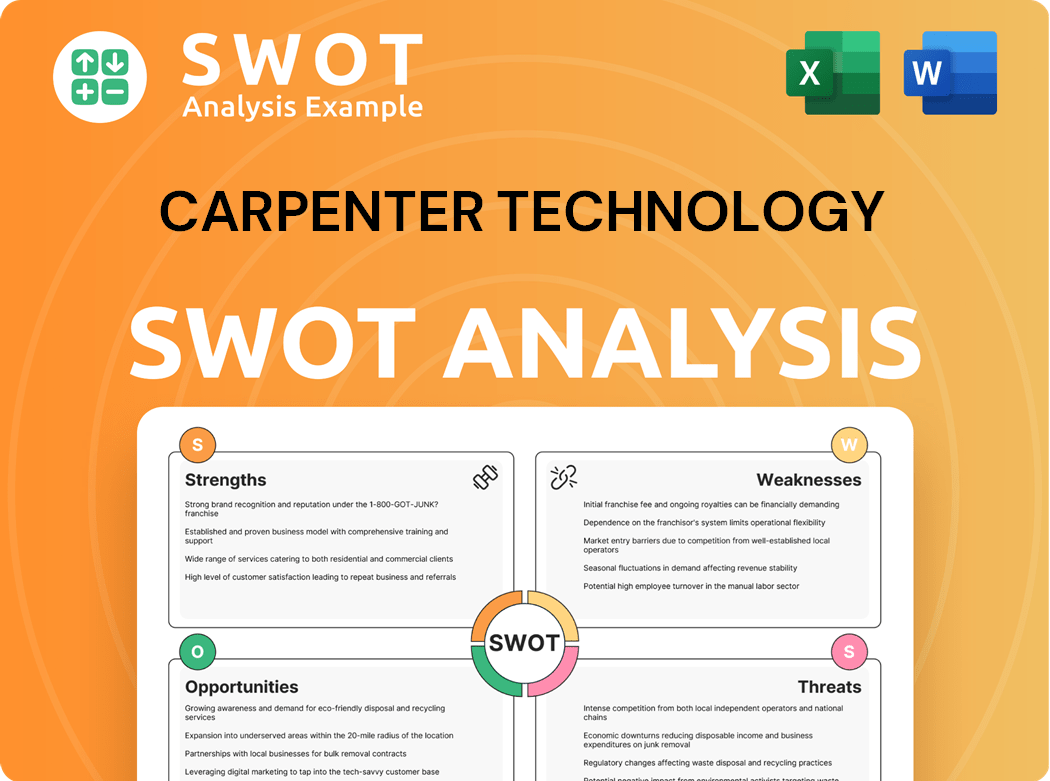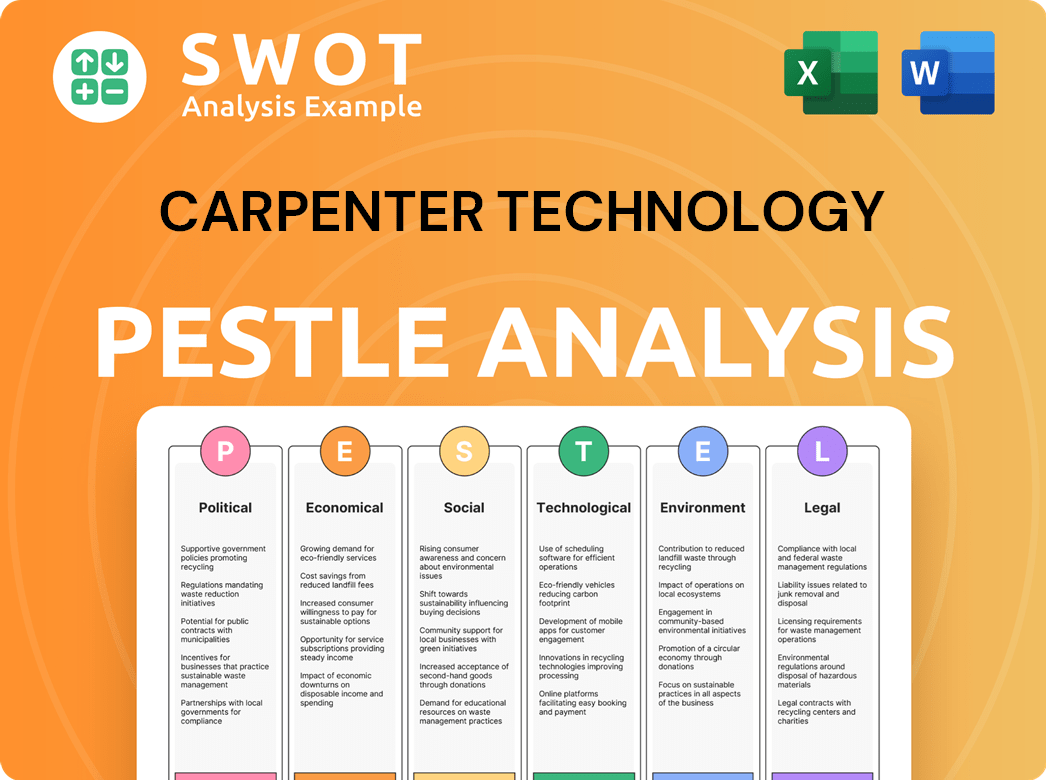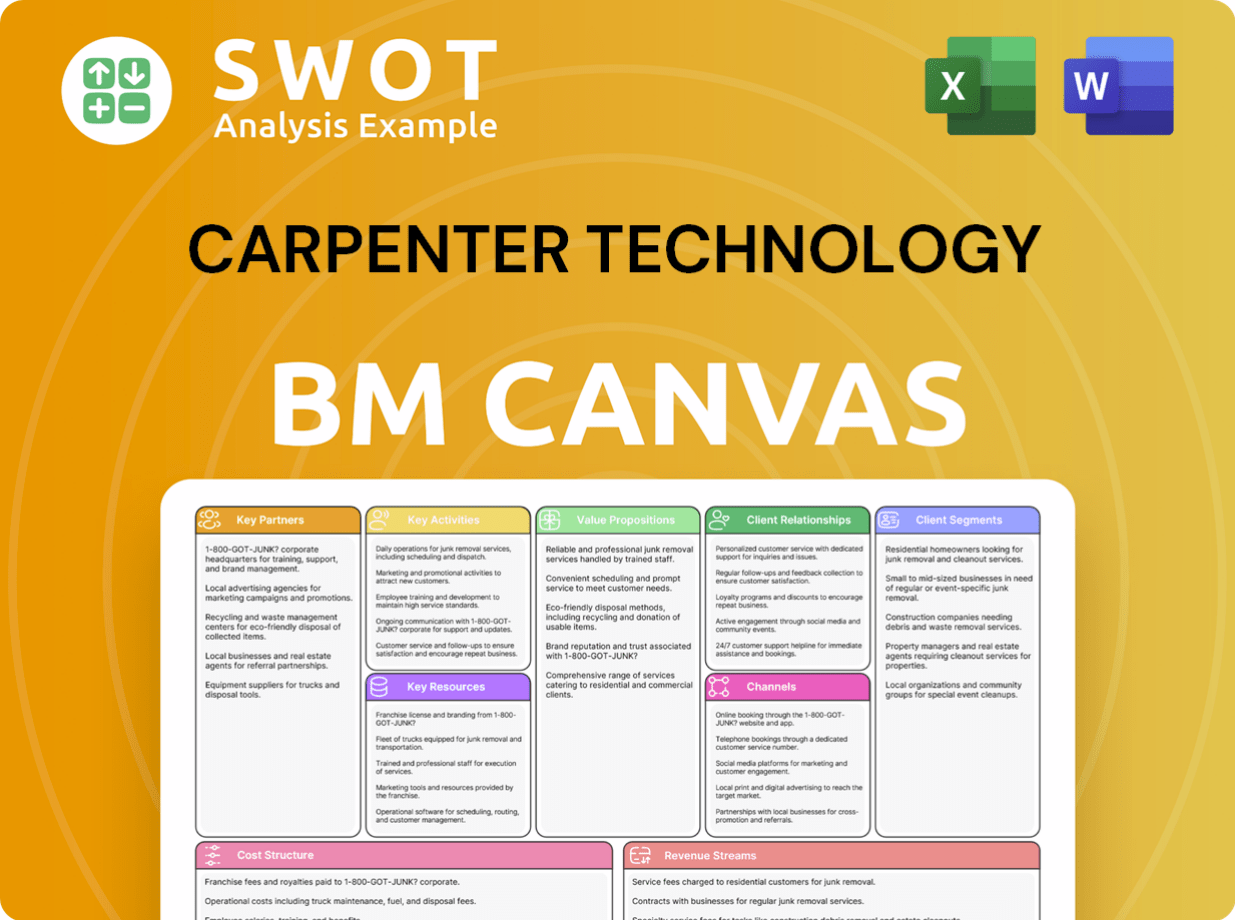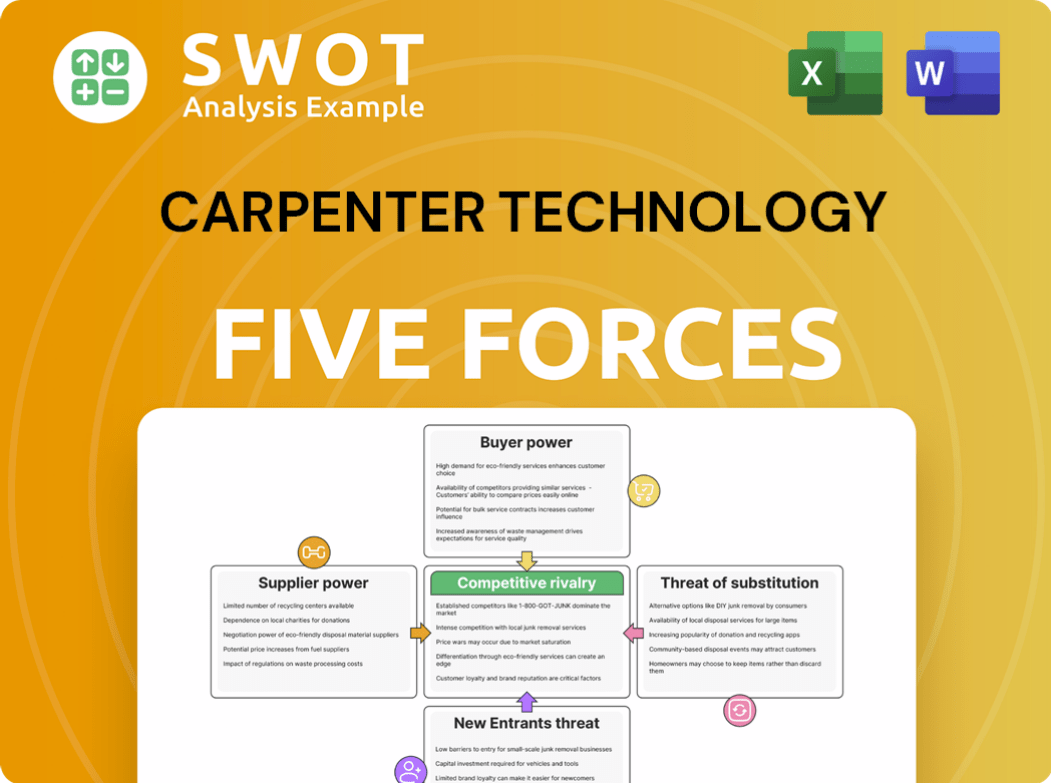Carpenter Technology Bundle
Decoding Carpenter Technology's Customer Base: Who Are They?
In the dynamic world of specialty alloys, understanding Carpenter Technology SWOT Analysis is key to unlocking its market success. Carpenter Technology, a leader in advanced materials, has strategically evolved its focus, making a deep dive into its customer demographics and target market essential. This analysis explores the company's shift from a general industrial approach to serving highly specialized sectors, highlighting the importance of understanding its customer profile.

Carpenter Technology's impressive financial performance, particularly in fiscal year 2024 and the projections for fiscal year 2025, underscores the effectiveness of its target market strategy. This success is directly tied to its ability to identify and cater to the precise needs of its target audience. A thorough market analysis reveals the industries Carpenter Technology serves, the size of its target market, and the customer acquisition strategies employed to maintain its leadership in the specialty materials industry. The company's ability to navigate complex market dynamics further emphasizes the importance of a well-defined customer and market understanding.
Who Are Carpenter Technology’s Main Customers?
Understanding the customer demographics and target market is crucial for assessing the business strategy of a company like Carpenter Technology. Carpenter Technology's primary focus is on business-to-business (B2B) relationships, serving specialized industries with high-performance materials. This approach shapes its customer profile and influences its market analysis.
The company's target audience is primarily composed of businesses in sectors that demand advanced materials. These sectors include aerospace, defense, medical, energy, and transportation. Analyzing Carpenter Technology's customer segmentation reveals a strategic emphasis on high-growth, high-value markets.
The company's success is closely tied to these key sectors, which drive demand for its specialized products. Further insights into the Marketing Strategy of Carpenter Technology can provide a deeper understanding of its approach to these markets.
The aerospace and defense sectors are the largest customer segment for Carpenter Technology. In 2024, this segment accounted for approximately 62% of the company's total revenue. The fourth quarter of fiscal year 2024 saw aerospace and defense sales, excluding surcharge, reach $376.3 million, representing 59% of net sales, and increasing by 19% sequentially.
The medical market is another significant segment for Carpenter Technology. It contributed 14% of net sales, excluding surcharge, in the fourth quarter of fiscal year 2024. In Q1 fiscal year 2025, medical revenues grew by 8.6% year-over-year, driven by higher sales in the orthopedic and dental segments.
The energy sector represents a smaller, but growing, segment. It accounted for 6% of net sales, excluding surcharge, in Q4 fiscal year 2024, with a 31% sequential increase. The power distribution segment within energy shows strong growth potential.
These markets also form part of Carpenter Technology's customer base. Transportation revenues declined by 31.4% in Q4 fiscal year 2024, while industrial and consumer revenues declined by 14.3%. These segments show varying performance.
Carpenter Technology's customer demographics are concentrated in high-value, specialized industries. The company's strategic focus is on sectors like aerospace, defense, and medical, which drive a significant portion of its revenue. The company's backlog, increased by 12% year-over-year as of March 31, 2024, further underscores strong demand from these target segments.
- Aerospace and defense are the primary revenue drivers.
- Medical and energy markets offer significant growth potential.
- Transportation and industrial & consumer markets have varied performance.
- The company's focus is on high-growth, high-value end markets.
Carpenter Technology SWOT Analysis
- Complete SWOT Breakdown
- Fully Customizable
- Editable in Excel & Word
- Professional Formatting
- Investor-Ready Format

What Do Carpenter Technology’s Customers Want?
Understanding the customer needs and preferences of Carpenter Technology is crucial for effective market analysis. The company's success hinges on its ability to meet the demands of its business-to-business (B2B) clients in demanding industries. This involves delivering high-performance specialty alloys and engineered products that meet stringent requirements.
The target market for Carpenter Technology primarily consists of entities requiring materials with exceptional reliability, strength, and resistance to extreme conditions. These customers, often in aerospace, medical, and energy sectors, have specific needs driven by the 'mission-critical' nature of their applications. This focus on quality and consistency is paramount.
The purchasing behavior of Carpenter Technology's customers is characterized by rigorous qualification processes and long-term contracts. Switching costs for customers can be substantial, estimated at $3.2 million per material transition due to recertification requirements and potential production changes. This highlights the importance of customer retention and the value of building strong relationships.
Customers prioritize material performance and adherence to precise engineering specifications. Carpenter Technology's ability to offer customized metallurgical solutions, with a 99.8% custom specification compliance rate, is a key differentiator. This tailored approach meets the unique needs of each industry.
The supplier's technical expertise and reputation are critical decision-making factors. Carpenter Technology's 130 years of experience and innovation in producing high-quality alloys build trust. This reputation assures customers of superior material performance and reliability.
Common pain points addressed include materials for extreme conditions, complex manufacturing like additive manufacturing, and the desire for extended product life cycles. The company invests heavily in research and development to meet these needs. In 2023, $157 million was invested in R&D.
Carpenter Technology employs a 'solutions-focused commercial approach' to drive high-value, high-growth demand. This involves optimizing product mix and pricing to meet specific segment requirements. The company has a broad portfolio of over 500 unique alloy compositions.
Carpenter Technology is developing alloys specifically engineered for additive manufacturing processes. This focus on advanced manufacturing technologies, with $62.3 million annually, positions the company to meet evolving customer needs. This demonstrates a commitment to innovation.
The company's success is built on long-term contracts and strong customer relationships. The high switching costs, estimated at $3.2 million, emphasize the value of retaining existing customers. These relationships are crucial for sustained growth.
Understanding the customer needs and preferences of Carpenter Technology is vital for effective market analysis and customer acquisition strategies. The company's target audience requires high-performance materials that meet stringent industry standards. The ability to provide customized solutions and technical expertise is crucial for success, as discussed in this article about Carpenter Technology.
- High-Performance Materials: Customers demand materials with exceptional reliability, strength, and resistance to extreme conditions.
- Customization: Tailored metallurgical solutions and adherence to precise engineering specifications are essential.
- Technical Expertise: A supplier's technical knowledge and reputation are significant decision-making factors.
- Advanced Manufacturing: Addressing evolving needs, such as additive manufacturing, is crucial.
- Long-Term Relationships: Building strong customer relationships and offering long-term contracts are vital for retention.
Carpenter Technology PESTLE Analysis
- Covers All 6 PESTLE Categories
- No Research Needed – Save Hours of Work
- Built by Experts, Trusted by Consultants
- Instant Download, Ready to Use
- 100% Editable, Fully Customizable

Where does Carpenter Technology operate?
The geographical market presence of Carpenter Technology is extensive, encompassing the United States, Canada, Mexico, Europe, and Asia. The company strategically operates service and distribution centers in these regions to facilitate the distribution of its specialty alloys and engineered products. This widespread presence enables the company to serve a diverse customer base across various industries globally.
The United States represents a significant market for Carpenter Technology, with sales increasing by 7% to $421.1 million in the quarter ending September 30, 2024. Europe is another key region, contributing 17.1% to the company's revenue in fiscal year 2023, and showing notable growth. The Asia Pacific region also plays a crucial role, accounting for 12.5% of the company's revenue in fiscal year 2023. These figures underscore the company's strong international presence and its ability to generate revenue from multiple markets.
Carpenter Technology's approach to its geographical market involves tailoring offerings and partnerships to address regional differences in customer demographics, preferences, and buying power. The company focuses on serving critical applications in sectors like aerospace, defense, medical, energy, and transportation. The company's ability to adapt to regional dynamics is crucial for its continued success, particularly in industries sensitive to economic fluctuations and technological advancements.
The United States is the largest single market for Carpenter Technology. In the quarter ending September 30, 2024, sales in the U.S. reached $421.1 million, demonstrating strong market penetration. The company's focus on high-performance alloys and engineered products aligns with the demands of key industries within the U.S.
Europe is a significant market for Carpenter Technology, contributing 17.1% to the company's revenue in fiscal year 2023. Sales outside the U.S. increased by 15% to $296.5 million in the quarter ending September 30, 2024. This growth highlights the importance of the European market and the company's ability to expand its footprint.
The Asia Pacific region accounted for 12.5% of Carpenter Technology's revenue in fiscal year 2023. This region represents a key area for growth, with strategic expansions planned. The company's focus on specialized solutions positions it well to capitalize on increasing demand.
Sales distribution by geography in fiscal year 2024 shows the United States at $1.39 billion, Europe at $387 million, Asia Pacific at $238 million, Mexico at $67 million, and Canada at $54.2 million. These figures highlight the company's diverse revenue streams across different geographical segments.
Carpenter Technology is actively expanding to meet regional demand, particularly in the aerospace sector. The company's Athens facility expansion will help capture incremental growth. They anticipate continued earnings growth beyond fiscal year 2025, driven by strong market demand and strategic actions.
- The company's focus on aerospace recovery impacts demand in regions with major manufacturing hubs.
- Adaptation to regional market dynamics is a key component of the company's strategy.
- Competitors Landscape of Carpenter Technology highlights the competitive environment.
- The company's strategic initiatives include increasing productivity, optimizing product mix, and pricing actions.
Carpenter Technology Business Model Canvas
- Complete 9-Block Business Model Canvas
- Effortlessly Communicate Your Business Strategy
- Investor-Ready BMC Format
- 100% Editable and Customizable
- Clear and Structured Layout

How Does Carpenter Technology Win & Keep Customers?
The company's customer acquisition and retention strategies are centered on its reputation for high-quality specialty alloys and engineered products. This reputation is crucial in industries like aerospace, defense, and medical, where material failure can have severe consequences. This focus leads to long-term contracts and enduring customer relationships, solidifying its market position.
The company's marketing approach primarily involves direct sales, technical support, and industry-specific engagements. This reflects its business-to-business (B2B) model, emphasizing building strong customer connections through a 'solutions-focused commercial approach.' This approach leverages its technical strength to solve customers' current and future challenges, positioning it as a preferred innovation partner.
Sales tactics include offering differentiated, value-added solutions to complex applications, which gives customers a competitive edge. The ability to provide customized metallurgical solutions with a 99.8% custom specification compliance is a key selling point. High switching costs, estimated at $3.2 million per material transition, also help retain customers.
The company relies heavily on direct sales and technical support to build strong relationships with its B2B clients. This approach allows for a deep understanding of customer needs and the ability to provide tailored solutions. The focus is on building intimate customer connections through a 'solutions-focused commercial approach'.
The company engages in industry-specific activities to enhance brand awareness and generate leads. This includes participation in trade shows, conferences, and industry events. These engagements are essential for showcasing its products and services to a targeted audience within specific sectors such as aerospace, defense, and medical.
The company offers customized metallurgical solutions to meet specific customer requirements. With a 99.8% custom specification compliance, the company provides tailored products that give clients a competitive advantage. This customization strategy drives customer loyalty and retention.
High switching costs, estimated at $3.2 million per material transition due to qualification and recertification processes, significantly contribute to customer retention. This makes it economically challenging for customers to switch suppliers, reinforcing long-term relationships. The company's focus on high-value end markets supports this strategy.
Customer data and segmentation are crucial for targeting campaigns, although specific CRM systems or detailed segmentation criteria are not publicly available. The company focuses on optimizing product mix and pricing for specific end-use markets, like aerospace, defense, and medical, demonstrating an understanding of segment-specific demand. The company's robust backlog, which increased by 12% year-over-year as of March 31, 2024, and is three times pre-pandemic levels, highlights effective acquisition and retention strategies. More details are available in the Growth Strategy of Carpenter Technology.
The company continuously targets high-growth, high-value end markets and applications. This strategic focus ensures alignment with evolving industry trends and customer needs. This approach helps the company maintain its competitive edge and attract new customers.
The company emphasizes improving productivity and operational efficiencies to enhance customer loyalty. This includes streamlining processes and reducing lead times to provide better service. These improvements contribute to competitive pricing and faster delivery times.
In the third quarter of fiscal year 2025, the Specialty Alloys Operations (SAO) segment expanded its adjusted operating margin to 29.1%, up from 21.4% in the prior year quarter. This improvement was driven by a better product mix, higher realized prices, and expanded operating efficiencies. These financial gains directly benefit customers.
The company fosters long-term partnerships with its customers by consistently supplying high-quality materials. This collaborative approach ensures that customers receive the support and resources they need. It also solidifies its position as a trusted supplier.
The company's customer-centric approach focuses on understanding and meeting customer needs. This involves providing tailored solutions and excellent customer service. This dedication to customer satisfaction drives retention and generates positive word-of-mouth referrals.
The company continuously invests in innovation to provide cutting-edge solutions. This commitment to innovation ensures that its offerings remain competitive and meet the evolving needs of its customers. Continuous innovation helps the company stay ahead of industry trends.
Carpenter Technology Porter's Five Forces Analysis
- Covers All 5 Competitive Forces in Detail
- Structured for Consultants, Students, and Founders
- 100% Editable in Microsoft Word & Excel
- Instant Digital Download – Use Immediately
- Compatible with Mac & PC – Fully Unlocked

Related Blogs
- What are Mission Vision & Core Values of Carpenter Technology Company?
- What is Competitive Landscape of Carpenter Technology Company?
- What is Growth Strategy and Future Prospects of Carpenter Technology Company?
- How Does Carpenter Technology Company Work?
- What is Sales and Marketing Strategy of Carpenter Technology Company?
- What is Brief History of Carpenter Technology Company?
- Who Owns Carpenter Technology Company?
Disclaimer
All information, articles, and product details provided on this website are for general informational and educational purposes only. We do not claim any ownership over, nor do we intend to infringe upon, any trademarks, copyrights, logos, brand names, or other intellectual property mentioned or depicted on this site. Such intellectual property remains the property of its respective owners, and any references here are made solely for identification or informational purposes, without implying any affiliation, endorsement, or partnership.
We make no representations or warranties, express or implied, regarding the accuracy, completeness, or suitability of any content or products presented. Nothing on this website should be construed as legal, tax, investment, financial, medical, or other professional advice. In addition, no part of this site—including articles or product references—constitutes a solicitation, recommendation, endorsement, advertisement, or offer to buy or sell any securities, franchises, or other financial instruments, particularly in jurisdictions where such activity would be unlawful.
All content is of a general nature and may not address the specific circumstances of any individual or entity. It is not a substitute for professional advice or services. Any actions you take based on the information provided here are strictly at your own risk. You accept full responsibility for any decisions or outcomes arising from your use of this website and agree to release us from any liability in connection with your use of, or reliance upon, the content or products found herein.